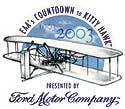
When the Wrights returned to Kitty Hawk on August 27, 1902, for their third fall of testing, they found they had much to do. Winter winds had blown the sand from beneath their glider shed, causing the floor to buckle on the ends; repairs were immediately begun. In the next three days, they also drove a well and built a smaller shed for their house. It was Spartan, with a well stocked kitchen, and camp beds were built "upstairs" in a small attic on the rafters beneath the roof.
Next, they proceeded to assemble their new glider. It was a slightly larger machine than the '01 model and, thanks to wind tunnel tests the previous winter, had a much more efficient wing surface. The glider had a wingspan of 32 feet, a wing area of 305 square feet, a horizontal rudder area of 15 square feet and a vertical double rudder area of 5.73 square feet. Overall, it was 16 feet long and weighed 112 pounds.
By September 15th, struts salvaged from the '01 machine were in place, and the completed wing set was taken out for a trial. Wilbur noted that the machine "was an immense improvement over last year's machine." Five days later, construction was finished and manned gliding began. The brothers were pleased. In two days they performed no fewer than 50 manned glides, with the machine performing exceptionally well.
|| |---| | | | In '02, Wilbur soared to new time and distance records.| The only irritant was a mouse that roamed their kitchen shelves, which Orville vowed to kill, setting a trap with cornbread. That night, he awoke to find the mouse crawling across his face. "Will advised me I had better get something to cover my face or get it 'chawed off,'" Orville later wrote. "I found on getting up that (the mouse) had only come to tell me to put more cornbread in the trap. He had disposed of the first piece. I have sworn vengeance …"
At breakfast a few days later, Orville (who still hadn't caught the mouse) made a remarkable announcement to Wilbur, and to their brother Lorin Wright and George Spratt, who had arrived in camp the day before. "While I was lying awake last night," Orville said, "I studied out a new vertical movable rudder to replace the fixed rudder we have used." Wilbur saw immediately that Orville had come up with a revolutionary idea-since a movable rudder would keep the craft level in the lateral plane, whereas a fixed rudder at times actually forced it into a tailspin when it tilted to one side. "We will connect the rudder and the wings with wires so as to operate them simultaneously," Wilbur stated. "One lever will control lateral balance. The other lever will keep the machine balanced fore and aft."
Once the movable rudder was installed, the Wrights (including Orville, who was still learning how to fly) were in the air from dawn to dusk. In two days, they made over 250 glides and were able to take the craft aloft in winds up to 30 miles per hour. Glides of 550 feet became commonplace. On October 23rd, their next-to-last day in the air, Wilbur set a record for time and distance, sailing 622.5 feet in 26 seconds. Orville was close behind at 615.5 and 21.
Little wonder they were elated when they left camp on October 28th. Their tests with the 1902 glider proved they had solved the basic problems of flight. Now they were ready for the final step, construction of a powered machine.
Orville never said if he caught the mouse.
This "Kitty Hawk Moment" is brought to you by the EAA, whose Countdown to Kitty Hawk program, presented by Ford Motor Company, includes an exact flying reproduction of the Wright Flyer. It is the centerpiece of the EAA's national tour during 2003, which will conclude with a five-day celebration at Kitty Hawk, North Carolina, where the Wright Flyer will fly again at exactly 10:35 a.m. on December 17, 2003, commemorating 100 years of powered flight.

Sign-up for newsletters & special offers!
Get the latest FLYING stories & special offers delivered directly to your inbox






